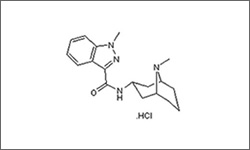Granisetron

Brand name:
Sancuso®
IUPAC:
1-methyl-N-(9-methyl-9-azabicyclo[3.3.1]nonan-7-yl)indazole-3-carboxamide
FDA approval:
Yes
Mechanism:
Granisetron is a 5-HT3 receptor antagonist, which is used to inhibit nauseous responses caused by chemotherapy. It has a strong affinity for this receptor and little for any other type and by blocking this receptor, granisetron prevents the the vomiting reflex.1
The diagram below shows the 3D molecular structure for Granisetron.
- 1 Granisetron. MedlinePlus. https://medlineplus.gov/druginfo/meds/a601211.html
